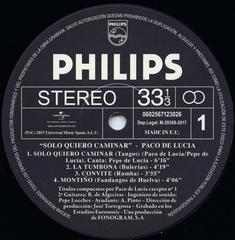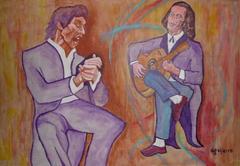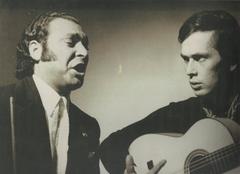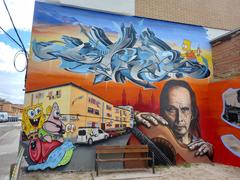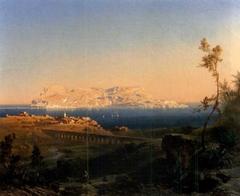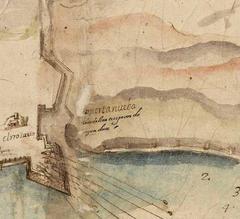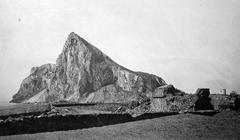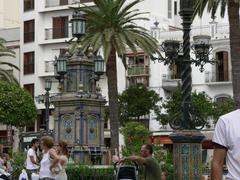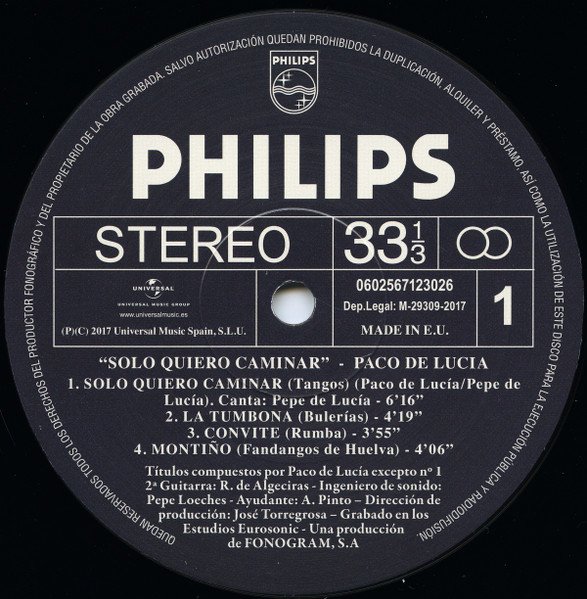
Paco de Lucía Visiting Hours, Tickets, and Historical Sites in Algeciras
Date: 14/06/2025
Introduction
Algeciras, a bustling port city on Spain’s southern coast, is more than just a gateway to Andalusia—it is the birthplace of Paco de Lucía, one of flamenco’s greatest innovators. Born Francisco Gustavo Sánchez Gómez in 1947, Paco de Lucía revolutionized the flamenco guitar, blending traditional rhythms with jazz, classical, and world music influences. His upbringing in the vibrant La Bajadilla neighborhood, shaped by both Andalusian and North African cultures, laid the foundation for a legacy that resonates globally (Nomads Travel Guide).
Today, Algeciras honors Paco de Lucía through monuments, cultural centers, and an immersive walking route that invites visitors to trace his life and artistry. Whether you’re a flamenco enthusiast or a curious traveler, this guide provides essential information on visiting hours, ticketing, accessibility, and local experiences, ensuring a memorable journey through the city’s musical and cultural heritage (Cadiz Turismo; Europa Sur; Audiala).
Contents Overview
- Paco de Lucía’s Early Life in Algeciras
- His Rise to International Fame
- Key Paco de Lucía Sites: Hours, Tickets & Accessibility
- Plaza Alta & Paco de Lucía Statue
- Paseo Paco de Lucía (Promenade)
- Centro Cultural Paco de Lucía (Cultural Center)
- Guided Tours & Special Events
- Self-Guided Paco de Lucía Route
- Practical Visitor Tips
- Annual Festivals & Events
- FAQ
- Conclusion & Recommendations
- Sources
Paco de Lucía’s Early Life in Algeciras
Paco de Lucía was born in Algeciras on December 21, 1947. His family, deeply rooted in flamenco tradition, lived in La Bajadilla, a working-class neighborhood that nurtured his musical passion. His father, Antonio Sánchez, was a guitarist and Paco’s first teacher, instilling discipline and love for flamenco. Surrounded by music at home—his brothers Ramón and Pepe also became notable musicians—Paco’s formative years were spent absorbing the rhythms and melodies of Algeciras (Nomads Travel Guide).
Rise to International Fame
Paco de Lucía’s extraordinary talent was evident by age 11, when he first performed on Radio Algeciras. At 14, he won a prize at the Concurso Internacional de Arte Flamenco in Jerez de la Frontera. His partnership with Camarón de la Isla in the 1960s and 1970s produced albums that transformed flamenco, introducing jazz and global influences. Paco’s 1976 album “Almoraima” marked a turning point, and collaborations with John McLaughlin, Al Di Meola, and Chick Corea brought him international acclaim. Recognized with the Premio Príncipe de Asturias de las Artes in 2004, Paco remains a central figure in world music (Nomads Travel Guide).
Key Paco de Lucía Sites: Hours, Tickets & Accessibility
Plaza Alta & Paco de Lucía Statue
- Location: City center, Plaza Alta
- Visiting Hours: Open 24/7
- Tickets: Free
- Accessibility: Wheelchair accessible
The iconic bronze statue of Paco de Lucía, unveiled in 2014, stands as a tribute in the heart of Algeciras. Sculpted by Nacho Falgueras, the statue captures Paco mid-performance, symbolizing his enduring legacy. The plaza’s lively atmosphere, lined with cafés and historic architecture, makes it a favorite spot for both locals and visitors (Nomads Travel Guide).
Paseo Paco de Lucía (Promenade)
- Location: Waterfront promenade
- Visiting Hours: Open daily, 24 hours
- Tickets: Free
- Accessibility: Partially wheelchair accessible; some uneven surfaces
The scenic promenade along Algeciras’s waterfront is dedicated to Paco de Lucía, offering stunning views of the Bay of Gibraltar. Informational plaques share insights about his life and music, creating an educational and picturesque route for visitors.
Centro Cultural Paco de Lucía (Cultural Center)
- Location: City center
- Visiting Hours: Tuesday–Saturday, 10:00–20:00; Sunday, 10:00–14:00; Closed Mondays
- Tickets: General admission €5; discounts for students/seniors; some concerts/workshops require separate tickets
- Accessibility: Fully wheelchair accessible
The Paco de Lucía Cultural Center hosts flamenco concerts, guitar workshops, and exhibitions. It serves as a hub for education and cultural exchange, drawing artists and fans from around the world. Tickets can be purchased onsite or online.
Guided Tours & Special Events
Local operators offer guided walking tours focused on Paco de Lucía’s life and the city’s flamenco heritage. Tours typically last 2–3 hours and are available in several languages. The annual Festival Internacional de Guitarra Paco de Lucía—held in late June or early July—features concerts, masterclasses, and competitions. Early booking is recommended due to high demand.
The Self-Guided Paco de Lucía Route
This curated walking route connects key locations from Paco de Lucía’s life:
- Birthplace (Calle San Francisco, No. 8): Marked by a commemorative plaque; exterior view only.
- Plaza Alta: Central gathering place and home to the Paco de Lucía statue.
- María Cristina Park: Urban park known for open-air flamenco in summer.
- Carnero Lighthouse (Punta del Faro): Panoramic views that inspired Paco’s compositions; accessible by car or a moderate hike.
- Rinconcillo Beach: Paco’s family beach house is private, but the public beach offers a serene spot for reflection.
- Visiting Hours: Route is accessible year-round; most sites are free.
- Tickets: No tickets required for route; museum entry approx. €3.
- Accessibility: Most sites are walkable; some areas (like Carnero Lighthouse) may be challenging for those with limited mobility.
For an interactive experience, visitors can download the Audiala app or pick up route maps at the Algeciras Tourist Office (Straits Escapes).
Practical Visitor Tips
Getting There and Around
- By Train/Bus: Algeciras is accessible from Málaga, Seville, and Cádiz. The train and bus stations are near the city center (Andalucia.com).
- By Car: Ample parking near the port and city center.
- Within Algeciras: Most key sites are walkable; taxis and buses are available for longer trips.
Best Times to Visit
- Spring & Autumn: Pleasant weather for walking and exploring.
- Festival Season (June–July): Experience live flamenco and special events.
Accommodation
- City Center Hotels: AC Hotel Algeciras and Hotel Reina Cristina are popular options (Nomads Travel Guide).
- Boutique Guesthouses: Offer local charm and personalized service.
Local Cuisine & Tapas
Sample Andalusian dishes such as grilled seafood, tortillitas de camarones (shrimp fritters), and choco frito (fried cuttlefish) at tapas bars around Plaza Alta and the port (Nomads Travel Guide; Andalucia.com). The Moroccan quarter offers mint tea and North African specialties.
Cultural Etiquette
- Respect performances and ask before photographing artists.
- Engage with local flamenco venues (“peñas”) to experience authentic music and dance.
Safety & Services
- Algeciras is generally safe; standard precautions against pickpocketing apply.
- Emergency number: 112.
- Tourist Information Office near Plaza Alta provides maps and guidance.
Annual Festivals & Events
- Paco de Lucía Festival: Late June/early July; concerts, masterclasses, and cultural activities.
- Encuentro Internacional de Guitarra Paco de Lucía: Workshops and performances with international artists.
Check event schedules via the Audiala app or local tourism offices.
Frequently Asked Questions (FAQ)
Q: Are there entrance fees for the Paco de Lucía statue or promenade?
A: No, both are outdoors and open to the public free of charge.
Q: Is the Paco de Lucía Route accessible for people with disabilities?
A: Most city-center sites are accessible, though the hike to Carnero Lighthouse is challenging for those with limited mobility.
Q: Can I book guided tours in advance?
A: Yes, advance booking is available through the Algeciras Tourist Office or local operators, especially during festival periods.
Q: Where can I find maps or more information?
A: The Tourist Information Office and the Audiala app provide up-to-date maps and resources.
Conclusion & Recommendations
Visiting Paco de Lucía’s Algeciras offers more than a glimpse into the life of a musical genius; it is a deep dive into Andalusian culture, community pride, and living flamenco tradition. The city’s monuments, cultural center, and annual events provide an immersive experience, suitable for both dedicated fans and first-time visitors. Take advantage of the accessible routes, guided tours, and local hospitality to make the most of your journey.
For updates, event information, and interactive guides, download the Audiala app and consult the Algeciras Tourist Office. Your visit supports the ongoing celebration and preservation of flamenco heritage.
Sources and Further Reading
- Nomads Travel Guide – Algeciras
- Straits Escapes – Things to Do in Algeciras
- Europa Sur – Paco de Lucía
- Andalucia.com – Algeciras
- Audiala – Algeciras
- Cadiz Turismo – Algeciras
- Ruta Paco de Lucía (Official Route Website)
